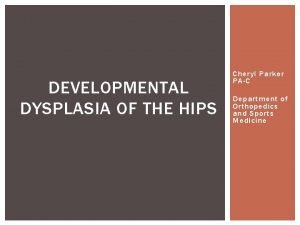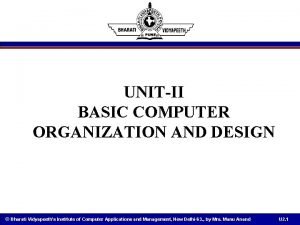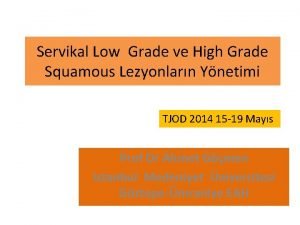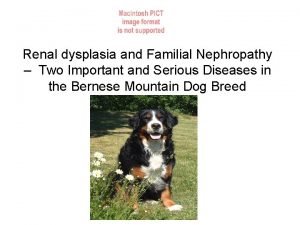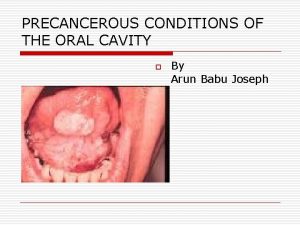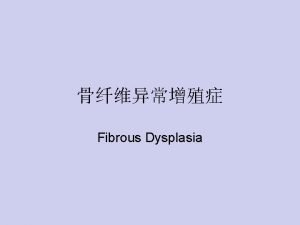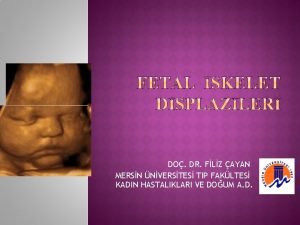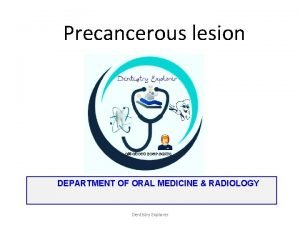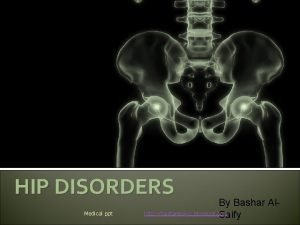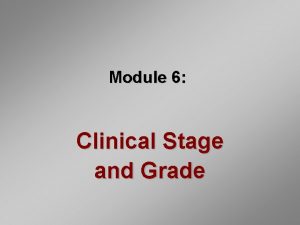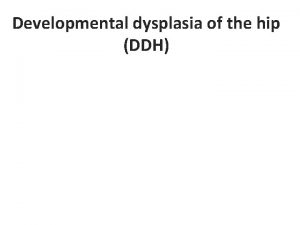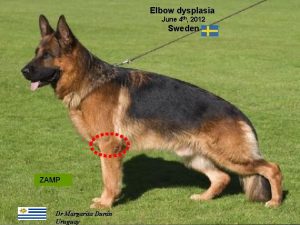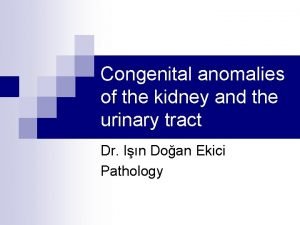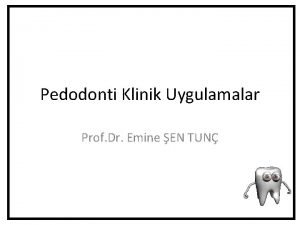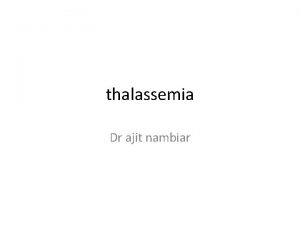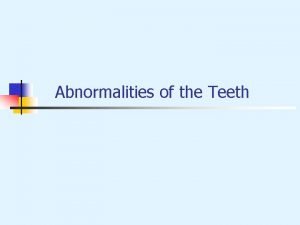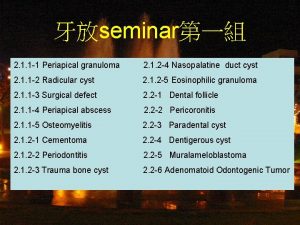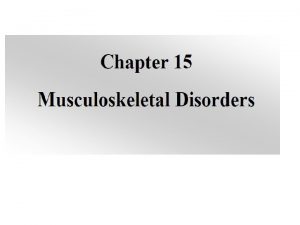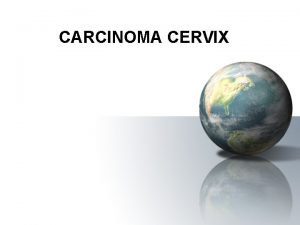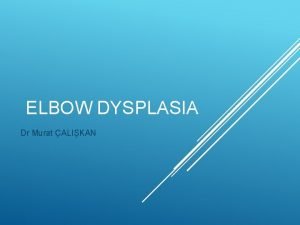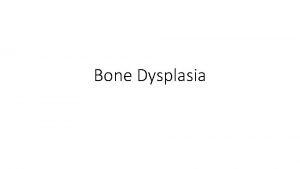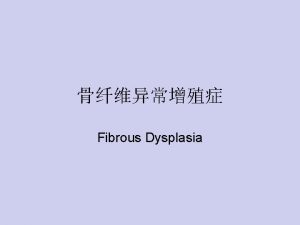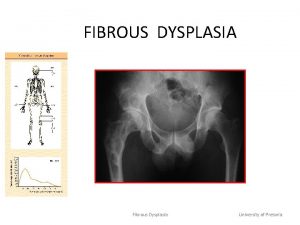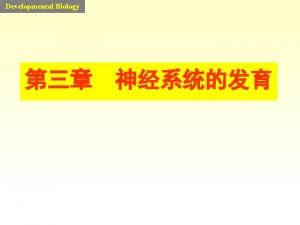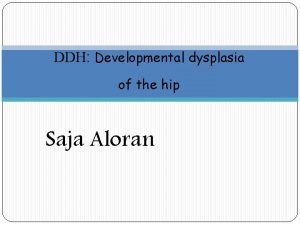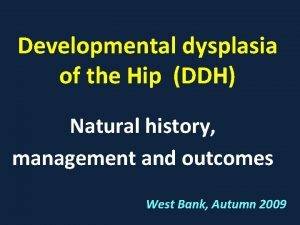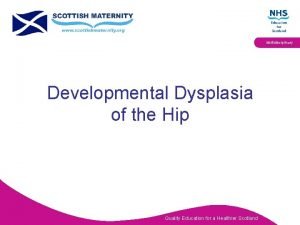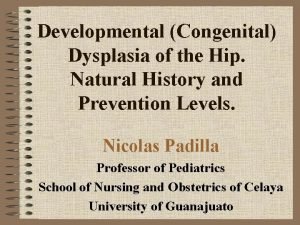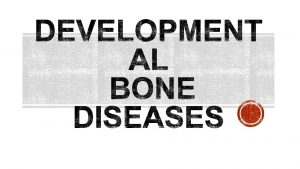Case Studies Discussion Updated 10122017 Developmental Dysplasia of


















- Slides: 18

Case Studies Discussion Updated 10/12/2017

Developmental Dysplasia of the Hip (DDH) • Hip bone slipping in and out of the hip socket • Overall treatment goals are to place the head of the femur back into the socket • Treatment can include splinting, bracing, casting, and/or surgery 10/31/2020

Case Study: DDH • In most instances, the child being treated for DDH will be unable to bend at the hip and maintain a sitting position required for use of a standard child safety seat • Alternative restraints such as a car bed, Hippo, or modified E-ZON may need to be considered • In some cases, a child safety seat with low sides will accommodate a cast 10/31/2020

Case Study: DDH Some surgeons may appreciate input from CPST and other health professionals on hip angles necessary for child restraint use. By increasing their awareness of issues related to transporting children in hip abduction devices, they may be receptive to casting at an angle conducive to restraint use, as there may be leeway in hip angle. 10/31/2020

Case Study: Omphalocele An omphalocele is a congenital abnormality in which the abdominal contents are outside the abdomen in a sac, due to a defect in the development of the muscles of the abdominal wall. 10/31/2020

Case Study: Omphalocele • Consult with the child’s surgeon and trial seats with the surgeon to determine the best options • Pressure from the chest clip and buckle prongs could be of concern and placement should be considered 10/31/2020

Case Study: Omphalocele • Initially, infants may require a car bed with restraint bag instead of a car seat with a harness • Before the child outgrows the car bed, consider feasible options with the surgeon • If the child can ride in a rearfacing seat, position rearfacing as long as possible 10/31/2020 Baby with omphalocele (circled) in restraint bag of Hope car bed

Case Study: Omphalocele • Consider rear-facing seat designed for children with omphaloceles • Secure prescribed medical equipment 9 months, 18 pounds Source: Children’s Hospital of the King’s Daughters, Norfolk, VA 10/31/2020

Halo Traction Metal frame attached to the skull for treatment of neck fractures, degenerative diseases of the cervical spine, and stabilizing the cervical spine postoperatively Child with halo 10/31/2020

Case Study: Halo Traction Consider an adjustable upright vest or harness for older children, with shoulder straps that can be unthreaded, routed through the frame and over the child’s shoulders for ease of use 10/31/2020

Case Study: Halo Traction • Select a seat that provides adequate room for the halo • Select a seat with a harness that is easy to route over the shoulders and secure o Rear-facing, select a seat with a harness that can be easily removed from a splitter plate and rerouted over the shoulders once the child is in the seat o Forward facing seats with harnesses may need to be reinstalled every time the child is restrained unless the harness can be removed and rerouted from the front of the seat o Make sure that the child can be evacuated in an emergency • Consider a seat that can be tethered. 10/31/202 0

Case Study: Halo Traction Consider a modified E-Z-ON vest for older children who must lie down 18 month old in modified E-Z-ON 10/31/2020

Case Study: Fragile X • Most common inherited cause of intellectual disabilities • Developmental delays • Mild to profound intellectual disabilities • Associated with behavioral challenges • May display violent outbursts, short attention spans, hyperactivity • Parents (usually mothers) may be affected 10/31/2020

Case Study: Fragile X • A car seat with a higher weight harness or large medical seat may provide securement for older children. Some large medical seats can be ordered with seat-specific accessories that deter escaping behaviors. • During school bus transportation, an upright travel vest or other school bus restraint system may be advised. 10/31/2020

Case Study: Fragile X • Children with behavioral challenges may also benefit from behavior plans. • Parent, usually mother, may need repetition of structured, clear, and simplified instructions. 10/31/2020

Case Study: Spinal Muscular Atrophy (SMA) • Spinal Muscular Atrophy is a motor neuron disease characterized by muscle wasting and motor impairment • There are varying degrees of severity of SMA • Children diagnosed with SMA may have severe hypotonia, respiratory problems, and feeding issues • Intellect and sensation are not affected 10/31/2020

Case Study: SMA • A car bed may be indicated in some cases • If an older child must lie down, a modified E-Z-ON vest may be necessary • Rear-facing as long as possible • If an older child can tolerate forward-facing, consider a forward-facing seat that can semirecline and has a higher weight harness • Some children may require an adaptive restraint with positioning accessories 10/31/2020

Case Study: SMA • If a child has a feeding tube, select a restraint that does not rub against the tube • Secure prescribed medical equipment • If possible, have an adult sit in the back seat and observe the child • Some children may require a wheelchair • Work with rehabilitation therapist 10/31/2020
 Piston test for hip dislocation
Piston test for hip dislocation What is performance monitoring and coaching form
What is performance monitoring and coaching form The symbol tsfa in alu operations include
The symbol tsfa in alu operations include Hpv pozitif smear negatif
Hpv pozitif smear negatif Dog kidney
Dog kidney Saw tooth appearance in lichen planus
Saw tooth appearance in lichen planus Ground glass appearance fibrous dysplasia
Ground glass appearance fibrous dysplasia Norberg szög
Norberg szög Diastrophic dysplasia
Diastrophic dysplasia Epithelial dysplasia
Epithelial dysplasia Hip dysplasia ppt
Hip dysplasia ppt Epithelial dysplasia
Epithelial dysplasia Von rosens splint
Von rosens splint Ununited anconeal process
Ununited anconeal process Renal dysplasia
Renal dysplasia Supernumere diş
Supernumere diş Hydrops
Hydrops Turner incisor
Turner incisor Periapical
Periapical
